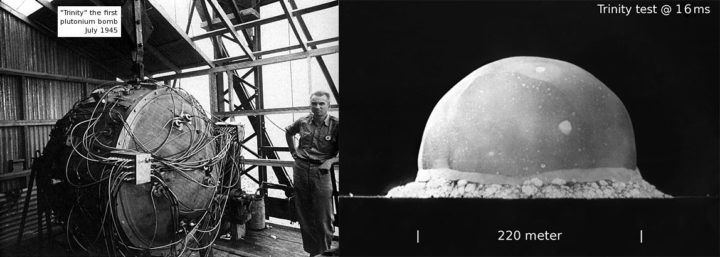By Patrick Moore.
History: As the clouds of war grew darker in 1939, the United States government undertook the highly secretive task of developing the first atomic bomb in the belief that Germany was working towards the same goal. In what would later be known as the Manhattan Project (because the Army Corp of Engineers began the project in Manhattan, NY) government laboratories would span America from Washington state all the way to rural Tennessee. The project was not without its own internal controversy, as many scientists were totally against the use of a technology that would slaughter civilians. At the same time, some were opposed to its testing altogether.
Seventy-five years ago, in July of 1945, the first atomic bomb test was conducted at the Trinity site in the desert of New Mexico. The bomb, named Gadget, packed a punch equivalent to more than 21,000 tons of TNT and was built from plutonium manufactured in Hanford Washington. Airborne fallout from the Trinity test (and hundreds more that would follow) irradiated indigenous communities downwind here in the US. Several months later, victims of the bombing in Japan would call this fallout black rain. It is worth noting that after the Trinity test, more than 200 scientists wrote a letter directly to then-President Truman, urging him not to use the atomic bomb on Japan.
The Manhattan Project gave birth to a whole new era during which the power of atoms was expected to produce ‘endless’ energy. At the same time, the implications of the Manhattan Project would give rise to a whole new approach to war as well – that of atomic and nuclear weapons. Within a span of just three days in August 1945, the US military dropped two atomic bombs on the Japanese cities of Hiroshima (enriched uranium 235) and Nagasaki (plutonium 239). Several hundred thousand Japanese civilians were slaughtered when the atomic bombs were dropped, half on the first day of the bombing alone!
In his memoirs, President Eisenhower, who was a WWII five-star General at the time, was against dropping the bombs and lamented their use on targets in Japan:
“I voiced to him my grave misgivings, first on the basis of my belief that Japan was already defeated and that dropping the bomb was completely unnecessary, and secondly because I thought that our country should avoid shocking world opinion by the use of a weapon whose employment was, I thought, no longer mandatory as a measure to save American lives. It was my belief that Japan was, at that very moment, seeking some way to surrender with a minimum loss of ‘face.’”
Even Eisenhower could not stop the Trinity test or the subsequent bombings. Now, with the release of archived records, we know that the atomic bombs were not needed at all!
Let’s review: the first nuclear chain reaction was tested in 1941, and by 1944 atomic reactors were operating in the US to create plutonium for its weapons program. The United States already had the ability to harness the atom to make heat (and create nuclear waste) a whole year before the Trinity test. Eisenhower and others knew that Germany was already defeated, and Japan could no longer sustain itself and was close to surrendering even before the Trinity test. The atomic bombs were dropped on Hiroshima and Nagasaki, nonetheless.
Why the Trinity test, then? Having the capability is different than using it. Unfortunately, the United States government and military did both. The legacy left behind is one that has already impacted generations of people throughout the world and will for generations to come if not forever! More importantly, that legacy was contrived, especially since dropping the atomic bombs was done with the premise of ‘defeating Japan’, yet Japan was already on its knees.
We encourage our followers to attend this virtual 75th commemoration event on Thursday, July 16th.
Commemoration Event details:
Trinity Downwinders: 75 Years and Waiting
Thursday, July 16, 2020
Virtual Event at 9:00 a.m. MDT
[8 a.m. Pacific/10 a.m. Central/11 a.m. Eastern]
Access at www.trinitydownwinders.com






